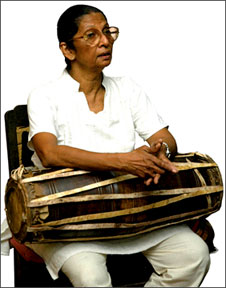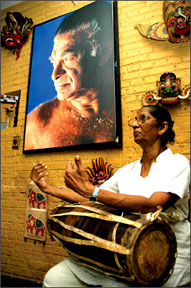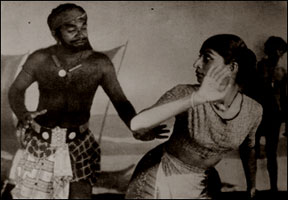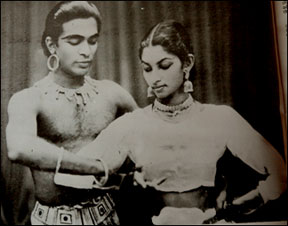Culture
In a different light:
Vajira Chitrasena
By Aditha Dissanayake
[email protected]
 For the first time in my life I get to know the real meaning of the
word ethereal. Dressed as she is in a white kurtha, hair tied in a knot
at the nape of her neck with silver strands glistening here and there,
with the kude gatha... - beat of a low country drum thundering as
background music when I enter the office room of Vajira Chirtrasena at
the Chitrasena Vajira Kalayathanaya on Alvitigala Mawatha, I cannot help
but mutter under my breath “She is beautiful”. For the first time in my life I get to know the real meaning of the
word ethereal. Dressed as she is in a white kurtha, hair tied in a knot
at the nape of her neck with silver strands glistening here and there,
with the kude gatha... - beat of a low country drum thundering as
background music when I enter the office room of Vajira Chirtrasena at
the Chitrasena Vajira Kalayathanaya on Alvitigala Mawatha, I cannot help
but mutter under my breath “She is beautiful”.
Then I remember that by the time this article appears in print she
would have turned seventy six. If to be seventy six means to be like
Vajira, I decide, I cannot wait till I get there.
The delicacy and grace of her movements as she sailed through the air
in perfect harmony with the rhythm of the beating drums in plays like
Karadiya and more recently, Berahanda are still there.So too the
toughness and the resilience.
My heart skips several beats when she says without preamble “I feel I
have been talking too much to the press recently. It feels almost like
yesterday that I spoke about Chitrasena on his birth anniversary in
January.
“But this is about you” I remind her gently. “That is worse” comes
the quick retort. Then she looks at me and smiles. Seeing that warm
glint of love sparkling behind the brown spectacles I find the courage
to venture beyond territory I would not otherwise have dared to go - to
discover Vajira Chitrasena in a new light.
To know her not as the dancing partner described by critics as “the
exceptional leading dancer” of Chitrasena, but as his sweetheart, as his
wife and as the mother of his three children. To see her not as the
foremost ballerina in the country but as a great-grandmother, eager as
every other great grandmother to talk about the achievements of the
extremely talented little ones.
 |
|
“The older you get the more
experience you have to give the young people |
This is not easy. In the same way the fragrance of a jasmine cannot
be separated from its petals, Vajira cannot be separated from dancing.
Drawing my attention to her daughter Upeka who is seen dancing with her
students in the hall in front of us she says this tradition of the
teacher dancing with the students was one begun by Chitrasena and one
which is continued to this day now by Upeka.
“When I was a student I used to dance behind Chitrasena. Then I
danced with our students and now Upeka is doing the same. There was a
time when all of us danced together with the students. We were connected
to each other (through our dancing).
Now begins a lesson on the bar exercises. Taking on the role of the
teacher, she explains the bar is not an instrument used only in the west
when it comes to practising dance movements. Kandyan dancers had used
the trunk of an arecanut tree as a bar. But before you begin exercising
on the bar there are other exercises you need to master; lying down
exercises, sleeping exercises etc.
She gets up from her chair holds its arms and bends her knees to show
how the bar was used in Kandyan dancing. Straightening herself with one
hand on her hips she laughs. “Your readers will know a lot about dancing
after reading your article”.
A lot about dancing and I hope a lot about the creator of these dance
forms too. How does she spend her days now that she has retired from the
stage. “I meditate from seven to eight in the morning and in the
evening, every day. This is not something new. I have been doing it for
quite some time now. My mother, who lived to be ninety-nine is the one
who introduced me to meditation.” She says until about sixty five she
had had no need to worry about her figure. Then she had begun to put on
weight; to expand around her waist and so she had started to exercise
regularly. “I am determined not to get too big so that I won’t be able
to carry myself around. She thinks its important that everyone of her
age group should see their weight as a ‘cumbersome thing’ and keep it
under control.
Calling her body as “no longer supple” but saying “I hope I will stay
on my feet till I die, she turns the pages of a book to show me dance
movements (stationary turns, stationary jumps etc.) which were similar
to the ones she had performed on stage. “I don’t have the strength to
demonstrate these movements now. You can’t be a dancer when you have to
sit and pant every few seconds”.

Chitrasena and Vajira as Mandadirala and Sisi in Karadiya |

He supported her in every possible way |
He supported her in every possible way
Even though age has kept her off the stage it has not prevented her
from encouraging the next generation. “The older you get the more
experience you have to give the younger people. We can show them how to
make a creation. We can give all the new material for them to work on”.
This ability to create something new from the Old Order is a talent
she says Chitrasena had in abundance. Looking back she marvels at the
way he had changed the conventional, barren stage in the 1940s into what
it is today.
“At a time when there was no stage craft in the country it was
Chitrasena who introduced costumes, lighting, etc. needed for a show.”
He had foreseen a certain form for Sri Lankan dancing and “what he
foresaw he worked to achieve, and achieve it he did”. She also
appreciates him for allowing her to do her own creations and for guiding
her in every way possible when it came to dancing.
She laughs when I ask her if she remembers a specific day or moment
when she realized she was in love with her Guru. “I used to see him
everyday. Chitra was a handsome man with lots of girls hanging around
him. He had hardly noticed her at first.
She remembers how he had played the role of Ravana while Irangani
Serasinghe played Sita in the Pageant of Lanka, played the role of the
deer and was not on their level at all. He never even looked at me at
that time”. She says.
“But you must have had admirers too” I remind her. By the time I had
admirers I was fully involved with him”.She recalls. Would it have been
difficult to have balanced the ‘artistic sides’ of their lives with the
normal? “It must have been” she says with laughter in her voice.
The great joy she had known as she traversed the best part of her
life besides Chitrasena is evident on her face when she walks up to the
book shelf - the only other item of furniture in her simple office room
apart from the desk and two chairs; the statues of the Buddha, Goddesses
Saraswathi and Lord Ganesh - takes a well thumped book on dancing called
the Baron Encore and turns to the flyleaf.
On it written in Chitrasena’s handwriting is the inscription “A
family, 1 son, 2 daughters. Father anxious to bring them up according to
his understanding of the world”.
An ambition fulfilled.
Having celebrated her 76th birthday twenty four hours ago she says
even though she is no longer in the “dance world” her creative abilities
are still at its best. “Your creative ability does not die as you get
older. It matures.” Does this mean a new creation is in the offing. “No.
To bring out a new creation you must have money. I have decided to stand
back and give whatever financial support that comes my way to the
younger generation”.
Finally, looking back at the years gone by she recalls one memorable
“bad moment”. The day she twisted her ankle two hours before a concert
on their second trip to Russia. “My sister was also in the troupe and
she stepped in to play my part.
With only two hours left before the play began there was no time to
prepare a new costume. She wore my clothes but because she was slightly
bigger than me the jacket wouldn’t close”. The Russian audience did not
know that the heroine on the stage was not Vajira but her sister.
This is only one among many memories she says and suggests I dig
deeper if I need to know more. Perhaps on another day when I compile the
biography of this national treasure praised by critics hailing from as
far as Switzerland as a dancer with “the highest technical mastery
together with profound religious concentration” (St. Gallen, 1970). Till
then, one final question.
If everything had gone well on that day long ago in Russia, apart
from having had to hobble around with a swollen ankle what would have
been the really bad moment that she remembers of the event. She beams
saying. “ I lost the chance to show myself off”.
No one who has the ability to fill their lives with love and laughter
ever grows old.
Now I know.
Focus: video art
by Sajitha Prematunge
[email protected]
There were plastic bottles, filled with water, placed in front of
every pillar that lined the length of the wall on either side of the
building. First we all thought they were art installations, since the
discussion of the day was art. To our astonishment (and my huge
embarrassment, since I was the one who made the inquiry) the head of the
IT department, University of Moratuwa explained that it was to prevent
the dogs from marking their territory! Thus began our introduction to
this years Artlink programme, of which the focus was video art.
Explaining why art was selected for such a venture, Olga Kisseleva,
one of the European participants of the programme, said it best when she
said “When we are looking at a piece of art, it’s emotional
understanding, which can rarely be grasped by any other form of
subject.” The art link programme is a 10 year old exchange programme for
amateur artists - involved in visual, fine arts and performing arts -
which are willing to think out of the box.
A collaboration effort by British Council, Goethe Institute, Alliance
Françoise and the Vibhavi Academy of Fine Arts, University of Moratuwa
has also joined the Artlink programme for this year. All expenses of the
programme are also covered by the three main partner institutions.
The exchange programme gives a limited number of local artists a
chance to mix with British, French and German artists. With the theme of
video art for the year 2008, the objective of this years Artlink
programme has been to encourage creativity in developing video art and
modern media in Sri Lanka.
A range of workshops, spanning from the 4th to 12th March, was held
at the faculty of architecture, University of Moratuwa, with the
participation of 15 local artists in all walks of life and three
Europeans - Elliot Dodd, Florian Thalhofer and Olga Kisseleva.
Elliot Dodd born in Jersey, Channel Islands was educated in
University of Western England, Bristol and Slade School of Fine Art,
University of London. Florian Thalhofer who lives and works in Berlin,
is a documentary film maker. Olga Kisseleva, born in Saint-Petersbourg,
primarily stays at New York University and the University of California.
The 15 local participants were divided into three groups and assigned
a European artist each. The objective of the Artlink programme in
integrating these artists was exchange of experiences, discussion and
identification of similarities and differences among the participants.
“It’s a win win situation where both sides will gain, learn and take
away many new ideas.” Said Peter Lang, Director German Cultural Centre.
The officials of partners in the project-Peter Lang, Jean Phillipe Roy,
Director, Alliance Françoise, Jill Westaway, Director of British Council
agree that - although some of them were not even involved with the
programme when it got off ground ten years ago - shaping the programme,
selecting the medium according to the technological development, was a
challenge in deed. Sri Lankan art has now developed to the state where
the medium has become laptops and mobile phones, instead of the
conventional brush and canvas!
The three teams resided in Subodhi Institute of Integral Education,
during the workshop. And this was no contemporary art workshop, devoid
of lectures the brainstorming sessions among the three groups sometimes
went well over midnight. Three projects are slowly taking shape out of
the discussions and exchange of ideas, the team members claim that they
are not worried about the outcome but the process that they under go to
get there.
Documentary film making has a style of its own. Olga Kisselevas said
that she and her teams objective was to focus on strict angles using
real and conceptual projections and individual expression through
projection. Florian Thalhofer, the inventor of Korsakow system - a
revolutionary software which enables simultaneous viewing of different
frames, says “I wanted to depict how an alien would picture our world
and how it would try to find patterns in our world.”
Florian and his team is the best example that these young minds have
much to share and learn from each other. Apart from art they have other
things in common, such as the problem of identity.
Sri Lankans according to Florian are very keen on preserving their
identity just as the French, German and British are concerned about
theirs. Elliot Dodds teams theme was illusions. Projecting light through
mosquito nets, glass, water and trees, the team seemed to agree that
what mattered was not the final product but the process that got them
there. |
